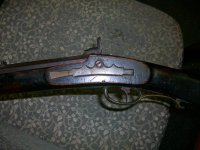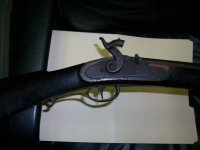I came across this rifle and I am told that it is 1775 era but it looks like if it is real it was converted to a percussion. I am by no means an expert or anything near an expert. I have searched Google and come up very little to clearly identify this rifle. I am thinking of picking it up as a present for my Dad...
What I do know:
35.25" Octagon Barrel
Single trigger
No visible/identifying markings
Anyone with additional information, comments or opinion of value...please PM or post.
Thank you in advance.
What I do know:
35.25" Octagon Barrel
Single trigger
No visible/identifying markings
Anyone with additional information, comments or opinion of value...please PM or post.
Thank you in advance.




